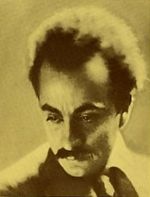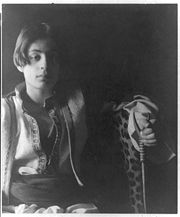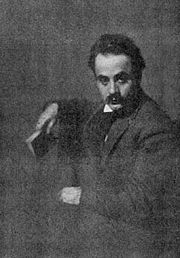Khalil Gibran
| Kahlil Gibran | |
|---|---|
 |
|
| Born | Gibrān Khalīl Gibrān bin Mikhā'īl bin Sa'ad January 6, 1883 Bsharri, Ottoman Syria |
| Died | April 10, 1931 (aged 48) New York City, United States |
| Occupation | Poet, Painter, Sculptor, Writer, Philosopher, Theologian, Visual Artist |
| Nationality | Lebanese-American |
| Genres | Poetry, Parable, Short Story |
| Literary movement | Mahjar, New York Pen League |
| Notable work(s) | The Prophet |
Kahlil Gibran (born Gibrān Khalīl Gibrān bin Mikhā'īl bin Sa'ad; Arabic جبران خليل جبران بن ميخائيل بن سعد), (born January 6, 1883 in Bsharri, modern day Lebanon, which was part of Ottoman controlled Syria at the time; died April 10, 1931 in New York City, United States) was a Lebanese American artist, poet, writer, philosopher and theologian. He is the third-bestselling poet in history after William Shakespeare and Laozi.[1]
Contents |
Youth
In Lebanon
Gibran was born in the Christian Maronite town of Bsharri in modern day northern Lebanon. His maternal grandfather was a Maronite Catholic priest.[2] His mother Kamila was thirty when Gibran was born; his father, also named Khalil, was her third husband.[3] As a result of his family's poverty, Gibran did not receive any formal schooling during his youth. However, priests visited him regularly and taught him about the Bible, as well as the Arabic and Syriac languages.
After Gibran's father, a tax collector, went to prison for alleged embezzlement,[1] Ottoman authorities confiscated his family's property. Authorities released Gibran's father in 1894, but the family had by then lost their home. Gibran's mother decided to follow her brother and emigrate to the United States. Kamila Gibran, along with Khalil, his younger sisters Mariana and Sultana, and his half-brother Peter left for New York on June 25, 1895.
In the United States

The Gibrans settled in Boston's South End, at the time the second largest Syrian/Lebanese-American community[4] in the United States. His mother began working as a pack peddler, selling lace and linens that she carried from door to door. Gibran started school on September 30, 1895. School officials placed him in a special class for immigrants to learn English. Gibran also enrolled in an art school at a nearby settlement house. Through his teachers there, he was introduced to the avant-garde Boston artist, photographer, and publisher Fred Holland Day,[1] who encouraged and supported Gibran in his creative endeavors. A publisher used some of Gibran's drawings for book covers in 1898.
At the age of fifteen, Gibran went back to Syria to study at a Maronite-run preparatory school and higher-education institute in Beirut. He started a student literary magazine with a classmate, and was elected "college poet". He stayed there for several years before returning to Boston in 1902. Two weeks before he got back, his sister Sultana died of tuberculosis at the age of 14. The next year, his brother Bhutros died of the same disease, and his mother died of cancer. His sister Marianna supported Gibran and herself by working at a dressmaker's shop.[1]
Art and poetry
Gibran held his first art exhibition of his drawings in 1904 in Boston, at Day's studio.[1] During this exhibition, Gibran met Mary Elizabeth Haskell, a respected headmistress ten years his senior. The two formed an important friendship that lasted the rest of Gibran's life. Though publicly discreet, their correspondence reveals an exalted intimacy. Haskell influenced not only Gibran's personal life, but also his career. In 1908, Gibran went to study art with Auguste Rodin in Paris for two years. This is where he met his art study partner and lifelong friend Youssef Howayek. He later studied art in Boston.
While most of Gibran's early writings were in Arabic, most of his work published after 1918 was in English. His first book for the publishing company Alfred Knopf, in 1918, was The Madman, a slim volume of aphorisms and parables written in biblical cadence somewhere between poetry and prose. Gibran also took part in the New York Pen League, also known as the "immigrant poets" (al-mahjar), alongside important Lebanese-American authors such as Ameen Rihani, Elia Abu Madi and Mikhail Naimy, a close friend and distinguished master of Arabic literature, whose descendants Gibran declared to be his own children, and whose nephew, Samir, is a godson of Gibran.

Much of Gibran's writings deal with Christianity, especially on the topic of spiritual love. His poetry is notable for its use of formal language, as well as insights on topics of life using spiritual terms. Gibran's best-known work is The Prophet, a book composed of twenty-six poetic essays. The book became especially popular during the 1960s with the American counterculture and New Age movements. Since it was first published in 1923, The Prophet has never been out of print and remains world-renowned to this day. Having been translated into more than twenty languages, it was one of the bestselling books of the twentieth century in the United States.
One of his most notable lines of poetry in the English-speaking world is from 'Sand and Foam' (1926), which reads : 'Half of what I say is meaningless, but I say it so that the other half may reach you'. This was taken by John Lennon and placed, though in a slightly altered form, into the song Julia from The Beatles' 1968 album The Beatles (a.k.a. The White Album).
Juliet Thompson, one of Kahlil Gibran's acquaintances, said that Gibran told her that he thought of `Abdu'l-Bahá, the leader of the Bahá'í Faith in his lifetime, all the way through writing The Prophet. `Abdu'l-Bahá's personage also influenced Jesus, The Son of Man, another book by Gibran. Gibran did two portraits of him during this period.[5]
Political Thought
Gibran was a prominent Syrian nationalist. In a political statement he drafted in 1911,[6] he expresses his loyalty to Greater Syria and to the safeguarding of Syria's national territorial integrity. He also called for the adoption of Arabic as a national language of Syria and the application of Arabic at all school levels.
When the Ottomans were finally driven out of Syria during World War I, Gibran's exhilaration was manifested in a sketch called "Free Syria" which appeared on the front page of al-Sa'ih's special "victory" edition. Moreover, in a draft of a play, still kept among his papers, Gibran expressed great hope for national independence and progress. This play, according to Kahlil Hawi,[7] "defines Gibran's belief in Syrian nationalism with great clarity, distinguishing it from both Lebanese and Arab nationalism, and showing us that nationalism lived in his mind, even at this late stage, side by side with internationalism."[8]
Death and legacy



Gibran died in New York City on April 10, 1931: the cause was determined to be cirrhosis of the liver and tuberculosis. Before his death, Gibran expressed the wish that he be buried in Lebanon. This wish was fulfilled in 1932, when Mary Haskell and his sister Mariana purchased the Mar Sarkis Monastery in Lebanon.
Gibran willed the contents of his studio to Mary Haskell. There she discovered her letters to him spanning twenty-three years. She initially agreed to burn them because of their intimacy, but recognizing their historical value she saved them. She gave them, along with his letters to her which she had also saved, to the University of North Carolina Library before she died in 1964. Excerpts of the over six hundred letters were published in "Beloved Prophet" in 1972.
Mary Haskell Minis (she wed Jacob Florance Minis in 1923) donated her personal collection of nearly one hundred original works of art by Gibran to the Telfair Museum of Art in Savannah, Georgia in 1950. Haskell had been thinking of placing her collection at the Telfair as early as 1914. In a letter to Gibran, she explained, "...I am thinking of other museums...the unique little Telfair Gallery in Savannah, Ga., that Gari Melchers chooses pictures for. There when I was a visiting child, form burst upon my astonished little soul." Haskell's gift to the Telfair is the largest public collection of Gibran’s visual art in the country, consisting of five oils and numerous works on paper rendered in the artist’s lyrical style, which reflects the influence of symbolism. The future American royalties to his books were willed to his hometown of Bsharri, to be "used for good causes", however, this led to years of controversy and violence over the distribution of the money;[9] eventually, the Lebanese government became the overseer.
Works
In Arabic:
- Nubthah fi Fan Al-Musiqa (1905)
- Ara'is al-Muruj (Nymphs of the Valley, also translated as Spirit Brides, 1906)
- al-Arwah al-Mutamarrida (Spirits Rebellious, 1908)
- al-Ajniha al-Mutakassira (Broken Wings, 1912)
- Dam'a wa Ibtisama (A Tear and A Smile, 1914)
- al-Mawakib (The Processions, 1919)
- al-‘Awāsif (The Tempests, 1920)
- al-Bada'i' waal-Tara'if (The New and the Marvellous,1923)
In English, prior to his death:
- The Madman (1918) (downloadable free version)
- Twenty Drawings (1919)
- The Forerunner (1920)
- The Prophet, (1923)
- Sand and Foam (1926)
- Kingdom Of The Imagination (1927)
- Jesus, The Son of Man (1928)
- The Earth Gods (1931)
Posthumous, in English:
- The Wanderer (1932)
- The Garden of the Prophet(1933)
- Lazarus and his Beloved (1933)
- Prose and Poems (1934)
- A Self-Portrait (1959)
- Thought and Meditations (1960)
- Spiritual sayings (1962)
- Voice of the master (1963)
- Mirrors of the Soul (1965)
- Death Of The Prophet (1979)
- The Vision (1994)
- Eye of the Prophet (1995)
Other:
- Beloved Prophet, The love letters of Kahlil Gibran and Mary Haskell, and her private journal (1972, edited by Virginia Hilu)
Memorials and honors
- Gibran Museum in Bsharri, Lebanon
- Gibran Khalil Gibran Garden, Beirut, Lebanon
- Khalil Gibran Street, Ville Saint-Laurent, Quebec, Canada inaugurated on 27 Sept. 2008 on occasion of the 125th anniversary of his birth.
- Gibran Khalil Gibran Skiing Piste, The Cedars Ski Resort, Lebanon
- Kahlil Gibran Memorial Garden in Washington, D.C.,[10] dedicated in 1990[11]
- Pavilion K. Gibran at École Pasteur in Montréal, Quebec, Canada
- Gibran Memorial Plaque in Copley Square, Boston, Massachusetts
- Khalil Gibran International Academy, a public high school in Brooklyn, NY, opened in September 2007
- Khalil Gibran Park (Parcul Khalil Gibran) in Bucharest, Romania
- Gibran Kalil Gibran sculpture on a marble pedestal indoors at Arab Memorial building at Curitiba, Paraná, Brazil
Mentions in popular culture
- Movies
- The Prophet is seen in the Johnny Cash biopic Walk the Line when June Carter hands it to J.R. to read in the motel.
- Gibran is quoted in South Central (film), "You may tie my hands with chains and my feet with shackles, and put me in the dark prison, but you shall not enslave my thinking, for it is free, like the breeze in the spacious sky."
- Music
- The Egyptian Singer Tony Kaldas Presented in 2008 Big Concerts celebrating the Jubilee 125 years of Gibran khalil Gibran Birth in The Egyptian Opera House and in Bibliotheca Alexandrina in Egypt. Also , he releases his 2 news songs from Gibran Words.
- Jazz saxophonist Jackie McLean's "Kahlil the Prophet" is on his album Destination...Out! (1963) (Blue Note BLP 4165)
- Brisbane based improvisational Jazz Quintet, The Neighbourhood Groove Collective, name 2 songs "The Firefly & the Stars" and "Love Crowns" on their second release titled "Pieces" inspired by imagery from the Prophet.
- Jason Mraz's song "God Rests In Reason" on the album Selections For Friends features words from the poem "The Prophet"
- The lyrics to David Bowie's "The Width of a Circle", off his album The Man Who Sold the World (1970), relates a surrealist scene in which the narrator and his doppelgänger seek the help of a blackbird, who just "laughed insane and quipped 'Kahlil Gibran'".
- Michigan experimental screamo outfit Men As Trees quote Gibran in the liner notes to their 2008 album, Weltschmerz: "We wanderers, ever seeking the lonelier way, begin no day where we have ended another day; and no sunrise finds us where sunset has left us."
- Tyrannosaurus Rex's second album, Prophets, Seers & Sages – The Angels of the Ages, released in October 1968, was dedicated in Gibran's memory.
- Guitarist Derek Trucks named his son Charles Khalil Trucks for saxophonist Charlie Parker, guitarist Charlie Christian, and Gibran.
- His book The Prophet is mentioned in the Mad Season's song, "River of deceit". "My pain is self-chosen. At least, so The Prophet says".
- The Chicago-based metal band Minsk's second album The Ritual Fires of Abandonment's lyrics are inspired by Gibran, who also is credited as an author of the lyrics in the CD booklet.
- Khalil Gibran is briefly mentioned in the Common Market song; 'Connect For'.
- Other
- Syrian mini-series titled "Gibran Khalil Gibran", broadcast on the Syrian state television in November 2008.
- In the popular video game Deus Ex, one of the three possible ending quotes is Gibran's quote: "Yesterday we obeyed kings and bent our necks before emperors. But today we kneel only to truth..." The western spelling of his name, Kahlil Gibran, was used to credit him.
- Gibran is referenced briefly in the episode Wingmen of the show The Boondocks. When Huey (the central character) is asked by his grandfather to say something "deep", he recites part of the poem "On Pain" from The Prophet.
- In the hit TV show "One Tree Hill", Lucas Scott (Chad Michael Murray) quotes Gibran.
- Gibran is referenced in the popular American sitcom "Friends". Richard, played by Tom Selleck, quotes from the friendship passage of "The Prophet" during a meal with Chandler and Monica. (Season 6)
- San Diego Padres shortstop Khalil Greene was named after Gibran.
- The Egyptian singer Tony Kaldas, who did especially for him in 2008 big concerts celebration for his Jubilee 125 years of his birth and released 2 songs from Gibran Khalil Gibran Words in Arabic
- In the 2000 TV Series "The Invisible Man", main character Darien Fawkes quotes Gibran on the subject of parents and children in the season 2 episode "The Camp."
References
- ↑ 1.0 1.1 1.2 1.3 1.4 Acocella, Joan. "Prophet Motive", The New Yorker, January 7, 2008
- ↑ Jagadisan, S. "Called by Life", The Hindu, January 5, 2003, accessed July 11, 2007
- ↑ "Kahlil Gibran (1883-1931)", biography at Cornell University library on-line site, retrieved February 4, 2008
- ↑ http://www.library.cornell.edu/colldev/mideast/gibrn.htm
- ↑ "Khalil Gibran and the Bahá'í Faith", excerpts from World Order, A Baha'i Magazine, Vol. 12, Number 4, Summer, 1978, pages 29-31
- ↑ Hawi, Kahlil Gibran: His Background, Character and Works, 1972, p155
- ↑ Hawi, Kahlil Gibran: His Background, Character and Works, 1972, p219
- ↑ Gibran and the national idea
- ↑ Prophet Motive: Books: The New Yorker
- ↑ Gibran Memorial in Washington, DC
- ↑ Elmaz Abinader, Children of Al-Mahjar: Arab American Literature Spans a Century", U.S. Society & Values, February 2000
- Kahlil Gibran and Ameen Rihani: Prophets of Lebanese-American Literature. Ed. by Naji B. Oueijan, et al. Louaize: Notre Dame Press, 1999.
External links
- The Gibran Archive: Biography, Timeline, Drawings/Paintings and many Full Text books
- Online copies of texts by Gibran
- Kahlil Gibran --a retrospective at YouTube, documentary, May 31, 2007
- Works by Khalil Gibran
- Gibran paintings and love letters
- History page links Gibran to W.B Yeats
- The Prophet by Gibran Parts of the Prophet in English, French, Czech and Arabic
- Music inspired by Khalil Gibran's immortal work, The Prophet